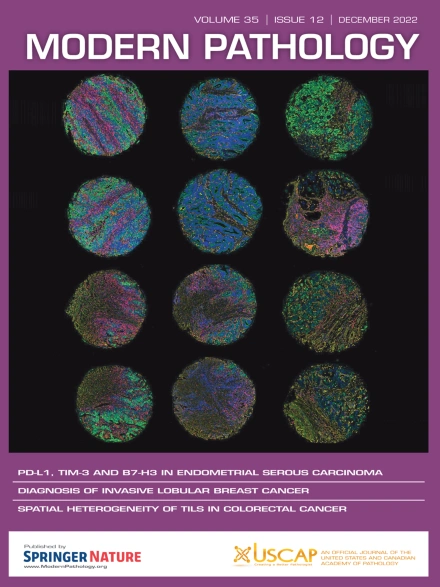前列腺导管腺癌再认识:临床病理和基因组特征识别出异质性疾病群,对患者管理具有重要意义。
IF 7.1
1区 医学
Q1 PATHOLOGY
引用次数: 0
摘要
前列腺导管腺癌(PDA)是一种侵袭性前列腺腺癌(PA)亚型。它可以在外周区发现,通常与腺泡PA相关,也可以在中央或周围发现,如尿道息肉。中心发生的PDA与外周PDA在生物学和遗传学上是否存在差异尚不清楚。将35例经切除标本诊断为PDA的患者根据PDA的位置分为3组[仅累及中央(尿道)(PDA- c)、同时累及中央和外周(PDA- c&p)、仅累及外周(PDA- p)],分析其临床病理、基因组学特征和预后。对2个PDA- c、8个PDA- c&p和12个PDA- p进行了靶向的下一代DNA和RNA测序,并对1425个癌症相关基因进行了全外显子覆盖。在11例PDA-P中,分别对同一患者的导管和相关腺泡成分进行测序。35例pda中,分别有2例(6%)、11例(31%)和22例(63%)为PDA-C、PDA-C&P和PDA-P。与PDA-P相比,PDA-C&P表现出更大的肿瘤大小(中位数为45 mm vs 25 mm), %导管成分(100% vs 30%),≥pT3疾病(100% vs 64%),内脏转移(36% vs 0%)和癌症特异性死亡率(27% vs 0%) (p本文章由计算机程序翻译,如有差异,请以英文原文为准。
Prostate Ductal Adenocarcinoma Revisited: Clinicopathological and Genomic Characterization Identifies Heterogenous Group of Diseases with Implications for Patient Management
Prostate ductal adenocarcinoma (PDA) is an aggressive subtype of prostate adenocarcinoma (PA). It can be found either in the peripheral zone, typically associated with acinar PA, or centrally in or around the verumontanum as a urethral polyp. Whether centrally occurring PDAs are biologically and genetically different compared with peripheral PDA remains unknown. Thirty-five PDAs diagnosed on resection specimens were categorized into 3 groups based on PDA location (central [urethra] involvement only [PDA-C], both central and peripheral involvement [PDA-C&P], peripheral involvement only [PDA-P]) and analyzed for clinicopathological, genomic characteristics, and outcomes. Targeted next-generation DNA and RNA sequencing with full exon coverage of 1425 cancer-related genes was performed on 2 PDA-C, 8 PDA-C&P, and 12 PDA-P with a grossly dissectible population of viable PDA. In 11 PDA-P, the same patients' ductal and associated acinar components were sequenced separately. Of 35 PDAs, 2 (6%), 11 (31%), and 22 (63%) were PDA-C, PDA-C&P, and PDA-P, respectively. PDA-C&P compared with PDA-P presented with larger tumor size (median 45 mm vs 25 mm), % ductal component (100% vs 30%), ≥ pT3 disease (100% vs 64%), visceral metastasis (36% vs 0%), and cancer-specific mortality (27% vs 0%) (P < .05) and enrichment for at least 1 DNA damage and repair (DDR)-related gene alterations (BRCA2, ATM, CDK12, ERCC2) (63% vs 8%), and PI3K pathway alterations (37% vs none). PDA-Ps were enriched in FOXA1 alterations compared with PDA-C&P (75% vs 25%) including 5 (56%) having FOXA1 mutation in only ductal components. TMPRSS2::ERG fusion was present in only 1 patient with PDA-P in both ductal and acinar components. One patient with PDA-C and 3 with PDA-C&P exhibited novel gene fusion ACPP::FGFR2 and NF1::ADAP, FGFR2::POC1B, and RB1:TTTY3, respectively. In 2 patients with PDA-C, PDA was eradicated in transurethral resection with no residual disease in follow-up radical prostatectomy. PDA-C lacked alterations in DDR genes. Our findings suggest that PDAs are clinically and genetically heterogeneous diseases. Understanding the heterogeneity of PDA is critically important in determining its biological potential and facilitating optimal patient management.
求助全文
通过发布文献求助,成功后即可免费获取论文全文。
去求助
来源期刊

Modern Pathology
医学-病理学
CiteScore
14.30
自引率
2.70%
发文量
174
审稿时长
18 days
期刊介绍:
Modern Pathology, an international journal under the ownership of The United States & Canadian Academy of Pathology (USCAP), serves as an authoritative platform for publishing top-tier clinical and translational research studies in pathology.
Original manuscripts are the primary focus of Modern Pathology, complemented by impactful editorials, reviews, and practice guidelines covering all facets of precision diagnostics in human pathology. The journal's scope includes advancements in molecular diagnostics and genomic classifications of diseases, breakthroughs in immune-oncology, computational science, applied bioinformatics, and digital pathology.
 求助内容:
求助内容: 应助结果提醒方式:
应助结果提醒方式:


